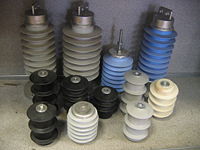Maintenance of valves and surge arresters
Electrical equipment may be under increased (compared to rated) voltage during lightning storms and mains switching. To limit surges, apply valve restrictors and surge arresters.
Different types of limiters are in operation — RVS, RVP, RVM, etc. non-linear resistor… Under normal operating conditions of the electrical installation, the spark gap separates live parts from ground and, when an overvoltage pulse occurs, cuts the wave dangerous overvoltage, while ensuring reliable arc quenching of the follower current (power frequency current flowing after the current pulse) when it first crosses zero.
 The spark gap for the appropriate voltage class is drawn from spark gap blocks placed in a porcelain cylinder.
The spark gap for the appropriate voltage class is drawn from spark gap blocks placed in a porcelain cylinder.
In valve stops, non-linear resistors are connected in series with the spark gap blocks.They consist of wheel drives assembled in blocks.
Discs have the ability to change resistance depending on the amount of voltage applied to them. As the voltage increases, their resistance decreases, which facilitates the passage of large impulse lightning currents with a small voltage drop through the arrester.
Disks of non-linear resistors are resistant to moisture and in a humid environment their characteristics deteriorate sharply. Therefore, all elements of valve restrictors are placed in hermetically sealed porcelain covers. Taps are grounded by connecting to a common grounding device.
 The effectiveness of valve limiter protection is determined by their distance from the protected equipment: the closer they are installed to the protected equipment, the more effective their protection. Surge limiter (non-linear surge limiter). Surge arresters are increasingly used to protect substations from surges. They differ from valve limiters in that there are no spark gaps and non-linear resistors are made of a completely different material.
The effectiveness of valve limiter protection is determined by their distance from the protected equipment: the closer they are installed to the protected equipment, the more effective their protection. Surge limiter (non-linear surge limiter). Surge arresters are increasingly used to protect substations from surges. They differ from valve limiters in that there are no spark gaps and non-linear resistors are made of a completely different material.
After triggering and reducing the voltage to the phase voltage, the accompanying current through the resistors is reduced to a few milliamps, making it possible to abandon the series spark gaps.
In the absence of spark gaps, a small conduction current flows through the resistors in normal mode. Prolonged conduction current leads to aging of the non-linear resistance.Therefore, in operation, the conduction current value is systematically checked and is not allowed to increase to values where thermal breakdown is possible.
Servicing limiters and surges. Their work is monitored according to the indications of recording operators. They are connected in series in the grounding circuit of the device and a pulsed current passes through them.
When inspecting valves and surge protectors, pay attention to the integrity of porcelain caps, reinforced seams and rubber seals.
The surface of the porcelain covers must always be clean, as surge arresters are not designed to operate in a contaminated atmosphere. Dirt on the tire surface distorts the voltage distribution across the arrester tread, which can lead to overlap even at rated operating voltage.
Operational experience shows that the following failures can occur within the protectors: breaks in the circuits of shunt resistors, wetting of disks from series resistors, etc. Such failures are usually detected during preventive tests. However, as the damage progresses, cracks may appear inside the protector that can be detected by the ear.
